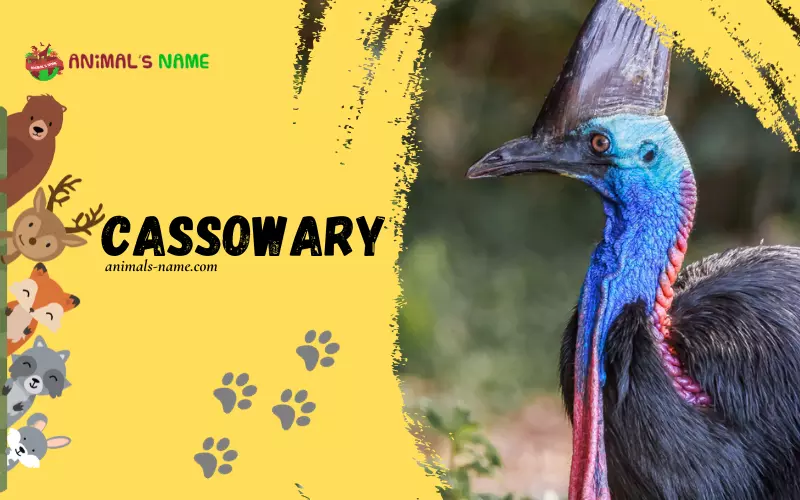Today, we are diving into the fascinating world of a unique bird called the Cassowary. Cassowaries are magnificent creatures known for their distinctive appearance, exciting history, and incredible habitat. These birds belong to the avian family, which includes various species worldwide. Here, we will explore these remarkable animals’ history, facts, size, habitat, and classification.
The history of the Cassowary dates back thousands of years. They have deep roots in the ancient cultures of Australia and Papua New Guinea. Revered as sacred animals, the Cassowary played a vital role in the folklore and traditions of these indigenous communities. Over time, these birds became renowned for their impressive features and extraordinary abilities, captivating the attention of many.
Cassowaries are known for their large size, with some species reaching up to 6 feet tall. These marvellous creatures display vibrant colours, such as black, blue, and red, making them incredibly eye-catching. Their strong legs, adorned with sharp claws, assist them in navigating through their lush rainforest habitat. Regarding habitat, Cassowaries are primarily found in the dense rainforests of Australia and Papua New Guinea, where they dwell amongst the towering trees and abundant foliage.
In terms of classification, Cassowaries belong to the family Casuariidae. There are three recognized species of Cassowaries: the Southern Cassowary, the Dwarf Cassowary, and the Northern Cassowary. Each of these species possesses distinct characteristics that set them apart. Understanding their classification helps us unravel these fascinating animals’ unique traits and behaviours.
History of Cassowary
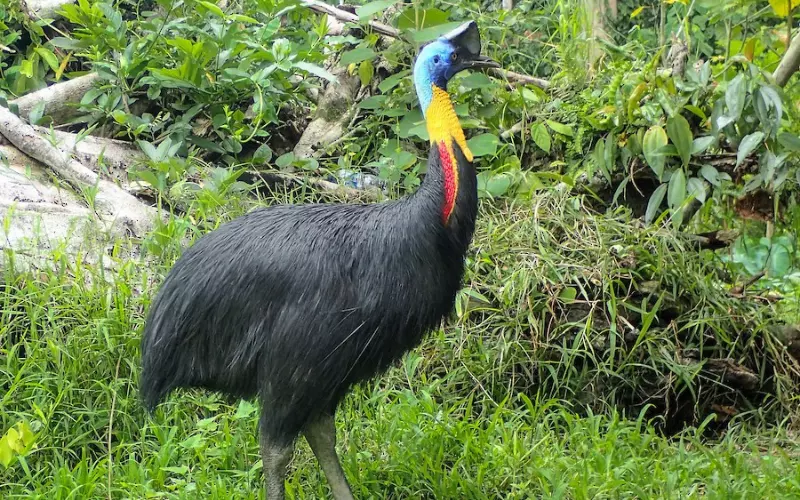
The cassowary bird has a long history that dates back millions of years. These majestic birds are native to the rainforests of Australia, New Guinea, and nearby islands. They have been essential to the region’s culture and ecosystem for centuries.
In ancient times, indigenous peoples revered the cassowary bird for its unique appearance and powerful presence. They believed the bird possessed mystical powers and played a vital role in their spiritual rituals. The cassowary feathers were highly valued and often used to create elaborate headdresses and ceremonial attire.
During the colonial era, European explorers encountered the cassowary bird for the first time. They were fascinated by its size and distinctive features, including a prominent head crest and bright blue skin on its neck. However, the cassowary’s reputation as a formidable creature quickly spread, as it is known for its solid kicks and aggressive nature, which can be dangerous if threatened.
Today, cassowary birds face numerous challenges, including habitat loss and hunting. Efforts are being made to protect this incredible species and its rainforest habitat, as they play a vital role in maintaining the balance of their ecosystems. By learning about and respecting the cassowary bird, we can help ensure that future generations witness this magnificent creature’s beauty and importance.
Importance of Cassowary
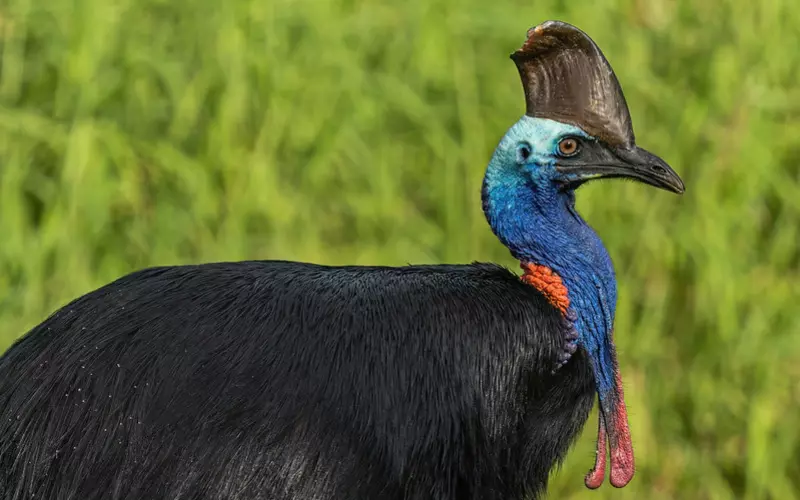
Cassowary birds are essential to the ecosystem of the rainforests they call home. They play a crucial role in seed dispersal, which helps to maintain and support the plant life in their habitat. When cassowaries consume fruits and seeds, they can travel long distances before excreting them, thus spreading the seeds and allowing new plants to grow in different rainforest areas. Without the cassowaries, many plant species would suffer as their seeds would not be able to reach new locations.
Furthermore, cassowaries help control specific animal populations in their environment. They feed on small vertebrates such as rodents and reptiles, preventing their numbers from becoming too high. This helps maintain a balance in the ecosystem, ensuring no species dominate and disrupt the rainforest’s delicate harmony.
From an ecological perspective, the presence of cassowary birds indicates a healthy and diverse rainforest ecosystem. Their existence is a sign that their environment is thriving and can support a wide range of plant and animal species. Protecting the cassowaries and their habitat is essential to ensure the continued health and balance of the rainforest ecosystem, which is crucial for the birds and the overall well-being of the planet.
Amazing Facts About Cassowary
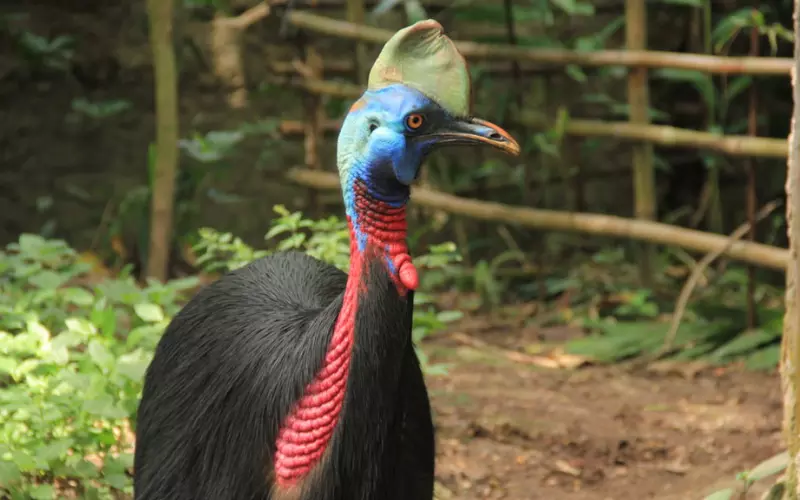
1. Cassowary birds are large, flightless birds found in the rainforests of Australia, New Guinea, and some surrounding islands.
2. They are considered one of the heaviest flightless birds, with adult males weighing up to 130 pounds (60 kilograms) and standing about 5.7 feet (1.7 meters) tall.
3. Female cassowaries are usually more extensive and brightly coloured than males, making them more dominant.
4. They have a unique appearance with a casque on their head and a bony crest like a helmet used for communication and protection.
5. Cassowaries have solid legs and three-toed feet with sharp claws, making them excellent runners. They can reach up to 31 miles per hour (50 kilometres).
6. These birds are primarily herbivorous, feeding on fruits, plants, and occasionally insects and small vertebrates.
7. Cassowaries play a vital role in the rainforest ecosystem by distributing seeds through their droppings, helping forest regeneration.
8. They are solitary birds and usually prefer to live alone, except during mating season or when raising their young.
9. These birds are known for their remarkable jumping ability to leap up to five feet (1.5 meters) in the air.
10. Unlike most birds, cassowaries have feathers that don’t provide insulation; instead, they repel water during rainy forest conditions.
11. Cassowaries are considered one of the most dangerous birds in the world due to their solid kicks and sharp claws. They can inflict severe injuries on humans or potential threats.
12. They have a low-pitched boom-like call that can be heard up to 1.2 miles (2 kilometres) away, which serves as a communication method to alert others of their presence.
13. Cassowaries are highly territorial, fiercely defending their space from other animals or intruding cassowaries.
14. These birds have a relatively long lifespan, averaging 40 to 50 years in the wild and even longer in captivity.
15. Cassowaries are considered vulnerable species due to habitat loss, hunting, and vehicle collisions. Conservation efforts are crucial to protect these fascinating birds and their unique rainforest habitat.
Can we keep Cassowary as our Pet?
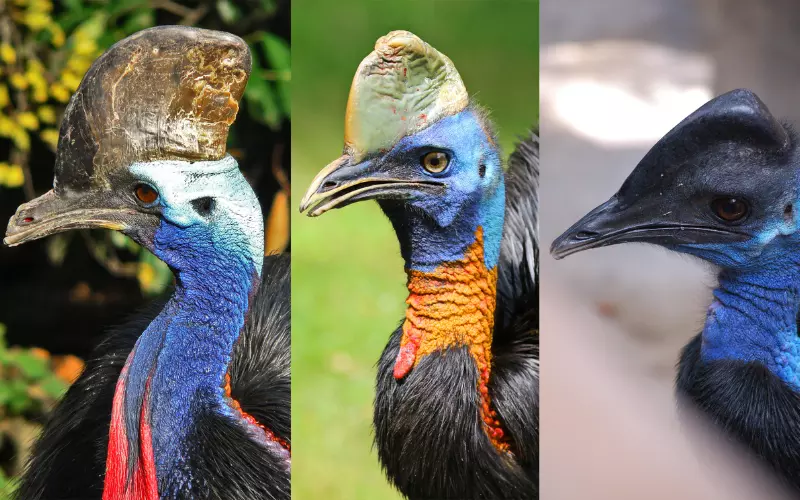
Keeping a cassowary bird as a pet is not a good idea. They are wild animals that should live freely in their natural habitat. It is not appropriate or safe for humans to keep them as pets. Even though they can be fascinating creatures, we must respect their right to live in the wild.
Unfortunately, the cassowary bird is facing the threat of extinction. Due to habitat loss and hunting, their numbers have been rapidly decreasing. It is our responsibility to protect these majestic animals and ensure their survival. The destruction of their natural habitat and illegal hunting has pushed them towards the brink of extinction.
Therefore, keeping cassowary birds as pets is impossible since they are already in danger of disappearing forever. Instead of capturing and domesticating them, focusing on conservation efforts and promoting awareness about their significance in the ecosystem is essential. We must work together to safeguard their habitat and reduce the factors contributing to their decline.
The cassowary birds should not be kept as pets because they are wild animals that should live freely in their natural habitat. Furthermore, they are currently facing the threat of extinction due to habitat loss and hunting. Instead of trying to keep them as pets, we must focus on their conservation and promote their well-being in the wild. Let us appreciate the beauty of these birds from a distance and strive to protect them for future generations.
Size of Cassowary
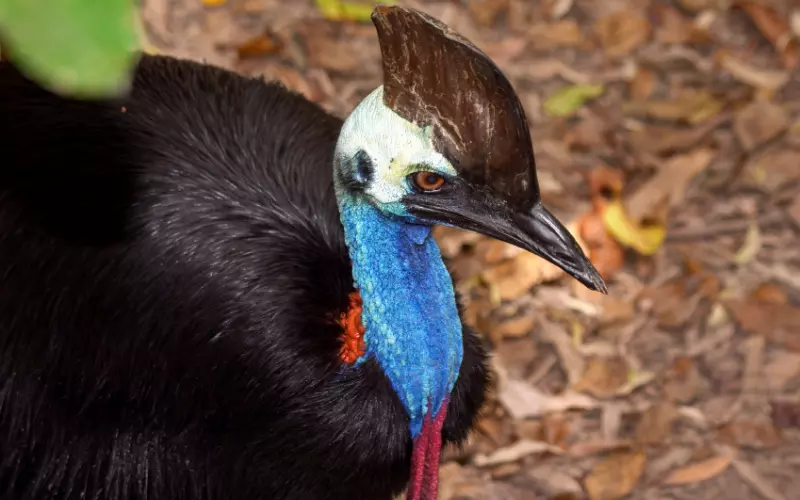
The Cassowary bird is a big bird that lives in the tropical rainforests of Australia and New Guinea. They are one of the most giant birds in the world, standing about 5 to 6 feet tall and weighing up to 130 pounds. That’s like having a bird as tall as a grown-up person and as heavy as a big dog!
Cassowaries have a unique appearance. They have a large, bony crest and bright blue necks on their head. Their feathers are black, which helps them blend in with the forest. One of the most striking features of the Cassowary is their strong legs with sharp claws. They use these legs to defend themselves if they feel threatened.
Because of their size, Cassowaries are not very good fliers but can run very fast. They can reach speeds up to 30 miles per hour! They also have potent kicks that can be dangerous. So it’s best to keep a safe distance and observe them from afar.
The Cassowary bird is a large and impressive creature. Its size can be compared to that of a grown-up person, and its weight to a big dog. With its unique appearance and powerful legs, this bird stands out in the rainforests of Australia and New Guinea.
Habitat of Cassowary

The cassowary bird is found in a particular home called a habitat. The habitat of a cassowary is in the rainforests of Australia and New Guinea. These rainforests are lush and dense, filled with tall trees, thick vegetation, and water. The cassowary feels right at home in this tropical environment.
The cassowaries can find everything they need in the rainforest habitat to survive. They have plenty of food, such as fruit, seeds, insects, and small animals. The tall trees provide shelter and protection from predators. The thick vegetation also helps the cassowary to hide and move around without being seen quickly. The water sources in the habitat are perfect for the cassowary to drink and bathe in to stay calm.
The habitat of a cassowary is essential for its survival. It provides the bird with the necessary resources to grow and reproduce. The rainforests are like a supermarket for the cassowary, offering a wide variety of food options. The dense vegetation helps the cassowary to avoid enemies and live in peace. A habitat is a safe place where the cassowary can find enough food, water, and shelter to lead a healthy and happy life.
Evolution of Cassowary

The Cassowary bird is a fascinating creature that has evolved over millions of years. Like other birds, it comes from a group of animals called dinosaurs. The ancestors of the Cassowaries were much more prominent and had different features than they do today. These birds have undergone many changes to become the magnificent creatures we see today.
In the ancient past, Cassowaries were even more significant and looked more like dinosaurs. They had long necks, tiny beaks, and sharp, curved claws on their feet. As time went on, they adapted to their changing environment. Their beaks became more extensive and robust, allowing them to eat a wider variety of food, such as fruits and insects. Their necks became shorter and sturdier, making it easier for them to move around the dense forests they inhabit.
Another significant change in their evolution came with the development of their feathers. Feathers helped Cassowaries to regulate their body temperature and provided protection. These birds also developed vibrant colours and unique patterns on their feathers, making them look even more beautiful. This adaptation helps them blend in with the forest environment and attract mates.
Through millions of years, Cassowaries have changed and adapted to their surroundings. They have become smaller, developed stronger beaks and shorter necks, and evolved stunning feathers. These adaptations have helped them survive and thrive in their natural habitat. It is incredible to witness how these fascinating birds have evolved, and they continue to amaze us with their unique traits and abilities.
Classification of Cassowary
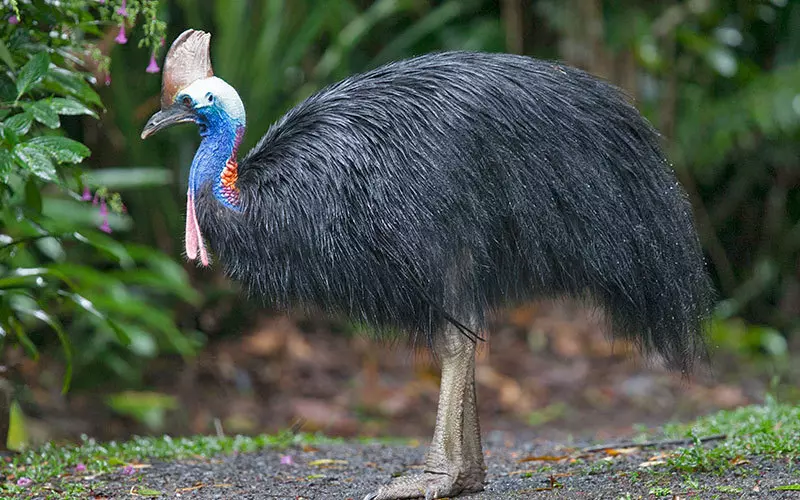
The cassowary bird belongs to the large, flightless birds known as ratites. These birds are found in the tropical rainforests of Australia, New Guinea, and nearby islands. There are three species of cassowary birds: the Southern cassowary, the Dwarf cassowary, and the Northern cassowary.
The Southern cassowary, also known as the double-wattled cassowary, is the largest species, reaching up to 6 feet tall and weighing around 130 pounds. This bird has shiny black feathers, a bright blue neck, and two bright red wattles hanging from its throat. The Dwarf cassowary is the smallest species, measuring about 3 feet tall and weighing around 90 pounds. It has brown feathers and a violet-blue neck. The Northern cassowary is the most colourful species, with red and blue patches on its neck and a brown body.
Cassowaries are known for their distinct physical features. They have a large bony crest on their heads called a casque, which may help amplify their calls and protect their skull while running through the dense forest. Their feet are equipped with sharp claws that can be used for self-defence or to tear apart fruits and other food. Despite their large size, cassowaries are excellent runners and can reach speeds up to 30 miles per hour.
The cassowary bird is a unique and fascinating species classified under the group of flightless birds called ratites. With its distinct physical features and vibrant colours, the cassowary captures the attention and curiosity of many. These birds are found in the rainforests of Australia and New Guinea and are essential in the ecosystem as seed dispersers. However, they are also considered endangered due to habitat loss and hunting. Overall, the cassowary bird is a remarkable creature that amazes and captivates researchers and nature enthusiasts alike.
Different Types of Cassowary
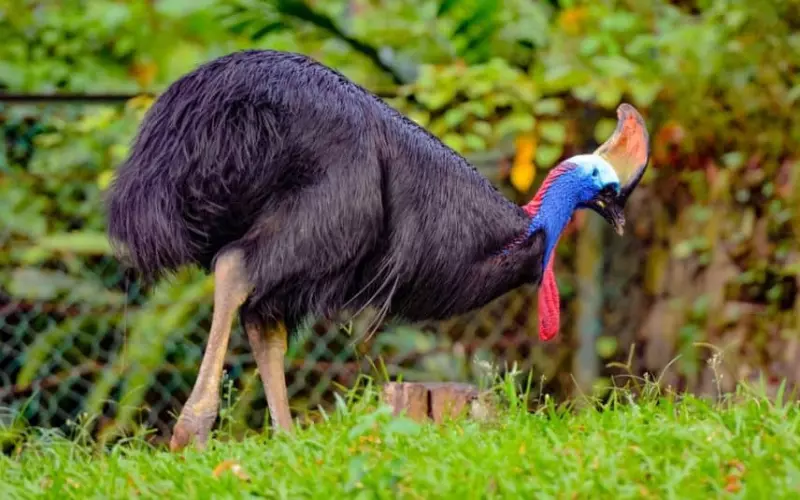
1. Southern Cassowary: The largest cassowary species found in the rainforests of New Guinea and northeastern Australia. With its vibrant blue and purple neck, this bird is known for its strong kicks and powerful claws that help it defend itself.
2. Dwarf Cassowary: A smaller cassowary species inhabiting New Guinea’s rainforests. Despite its size, this bird has a highly developed casque on its head that serves as protection and enhances its deep booming calls during mating season.
3. Northern Cassowary: Found in New Guinea’s and northern Australia’s rainforests, this species boasts a unique double casque on its head. The males undertake most of the nesting and rearing duties, including incubating the eggs.
4. Bennett’s Cassowary: Native to New Guinea, this species features a tall single casque on its head. The female of this bird is larger and more brightly coloured than the male, and it plays a dominant role in courtship and mating.
5. Queensland Cassowary: Inhabiting the northeastern regions of Australia, this bird plays a vital role in dispersing seeds due to its diet of various fruits. Its distinctive casque helps direct water away from its face during rainy weather.
6. Single-wattled cassowary: Found in New Guinea, this bird has a single delicate wattle, or fleshy growth, on its neck. The male takes charge of incubating the eggs and raising the chicks while the female moves on to find a new mate.
7. Blyth’s Cassowary: Native to the island of Seram in Indonesia, this bird has a unique casque that resembles a single-coloured helmet. It is known for its elaborate courtship displays, during which it often stretches its neck upward and makes deep vocalizations.
8. Moustached Kingfisher Cassowary: Inhabiting the island of New Britain in Papua New Guinea, this species has a casque resembling a moustache, hence its name. It tends to live in lowland rainforests and relies on its agility and fantastic jumping ability to navigate dense vegetation.
9. Golden-Neck Cassowary: Native to New Guinea, this bird is characterized by its bright yellow neck and intricate casque pattern. It typically inhabits remote mountain ranges, where it plays a crucial role in seed dispersal, particularly for large fruits.
10. Moluccan Cassowary: Found in the islands of Halmahera and Buru in Indonesia, this species has a large double casque that enhances its booming calls. It mainly consumes fallen fruits and has been observed engaging in territorial displays, which involve puffing up its neck and making deep vocalizations.
Geographical Presence of Cassowary
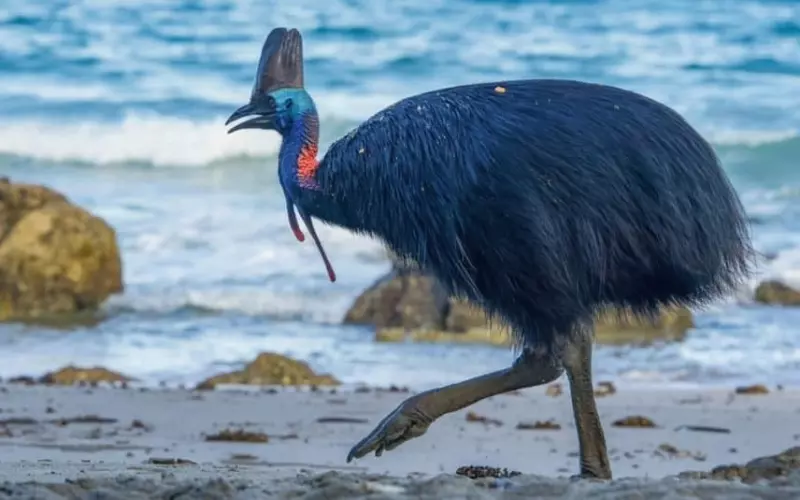
The Cassowary bird is found in the tropical rainforests of New Guinea and the surrounding islands, as well as in the northeastern part of Australia. These regions are known for their dense forests, hot and humid climates, and diverse wildlife. The Cassowary bird prefers to live in these areas due to the abundant rainfall and the availability of fruits, seeds, and insects, which make up its diet.
However, the Cassowary bird is not found in other parts of the world. It does not inhabit cold regions like Antarctica or the Arctic, where the weather is much colder, and the terrain is different. You won’t find the Cassowary bird in deserts or arid regions where water and vegetation are scarce. These birds need the humid and lush environment of the tropical rainforests to survive.
To summarize, the Cassowary bird thrives in the tropical rainforests of New Guinea, the surrounding islands, and the northeastern part of Australia. These regions provide the ideal conditions for the Cassowary bird to live comfortably. However, you won’t find these birds in cold regions, deserts, or arid areas where the environment is unsuitable for survival.
Scientific Name of Cassowary

The scientific name of the Cassowary bird is Casuarius casuarius. This large flightless bird is found in the rainforests of Australia, New Guinea, and some nearby islands. It is known for its unique appearance and interesting behaviours.
Cassowaries belong to the Ratite family, which includes other flightless birds like ostriches and emus. They are the third tallest bird in the world and can reach up to 5.9 feet. Their bodies are covered in black feathers, and they have brightly coloured blue heads and necks. They also have a large bony crest or casque on their heads, which adds to their distinctive look.
Cassowaries are omnivorous, meaning they eat both plants and small animals. They play an essential role in their ecosystems as seed dispersers, helping to spread the seeds of the fruits they consume. These birds are also known for their solid and dangerous kicks, which they use to defend themselves. They have long and sharp claws on their feet that can cause severe injuries if threatened.
The Cassowary bird, scientifically known as Casuarius casuarius, is a fascinating species found in the rainforests of Australia and New Guinea. It is a large flightless bird with a unique appearance, including a colourful head and neck and a bony crest on its head. Cassowaries are omnivorous and play a vital role in their ecosystems by spreading seeds. However, they should be cautiously approached due to their powerful kicks and sharp claws.
Diet of Cassowary
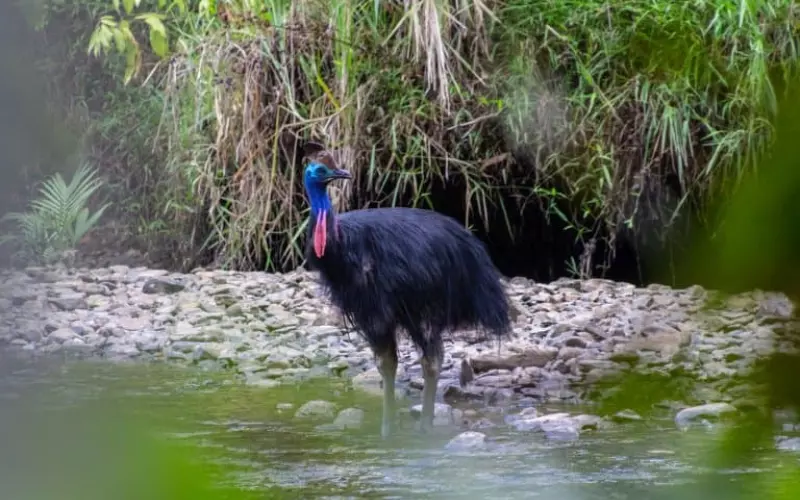
The diet of the cassowary bird mainly consists of fruits, seeds, and small animals. These large birds are omnivores, meaning they eat various foods to survive. Fruits are a significant part of their diet, and they particularly enjoy eating fallen fruit from trees. The cassowary bird also consumes seeds from various plants, which helps in dispersing these seeds throughout the forest.
In addition to fruits and seeds, the cassowary bird sometimes eats insects, small lizards, and frogs. They use their strong, sharp beak to capture and tear apart their prey. This makes them opportunistic feeders, as they eat whatever small animals they can find. Insects and other small creatures provide the cassowary bird with essential proteins and nutrients for their growth and survival.
Since fruits play a crucial role in their diet, cassowary birds contribute to forest regeneration. They eat fruits from different trees and then spread the seeds in their droppings as they move around. This helps new plants and trees grow in various forest areas, which is essential for maintaining a healthy ecosystem.
The cassowary bird has a varied diet, including fruits, seeds, and small animals. They play an essential role in the ecosystem by helping to disperse seeds and regrow plants. These fascinating birds are well-adapted to their environment and have developed unique feeding behaviours, allowing them to thrive in their forests.
Locomotion of Cassowary
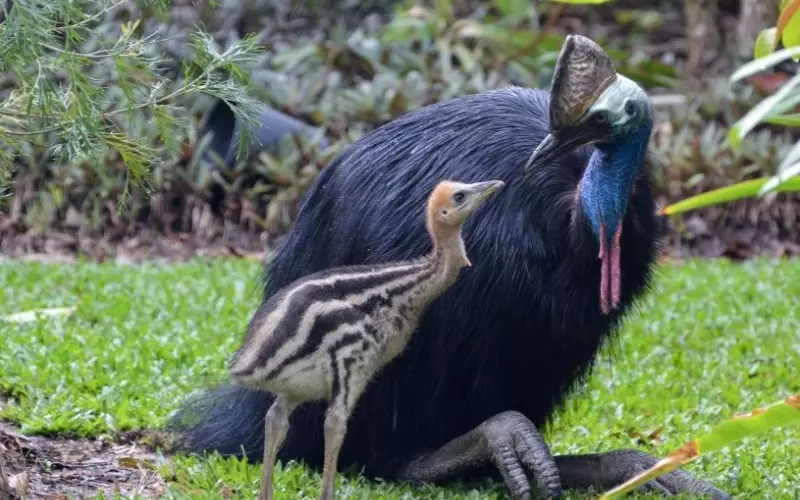
The Cassowary bird moves uniquely and interestingly. It has powerful legs that help it walk and run. When it walks, it holds its body upright and moves its feet slowly and deliberately. It takes each step carefully, placing its feet one in front of the other. This way of walking helps the Cassowary to maintain balance and provides stability while moving through its habitat.
When the Cassowary needs to run, it can do so quickly. It flaps its wings to help it balance and keep its body steady while running. With strong and muscular legs, the Cassowary can reach speeds of up to 31 miles per hour! Such impressive speed makes it one of the fastest-running birds in the world. The Cassowary’s locomotion is well-adapted to its environment, allowing it to move with confidence and agility.
Social and Sexual Behaviour of Cassowary

A solitary lifestyle characterizes the social behaviour of cassowary birds. These birds prefer to roam and search for food alone, without the company of other cassowaries. They are pretty independent and often defend their territories from other birds. Sometimes, male cassowaries may engage in aggressive encounters with each other, which involve raising the head crest, puffing up their necks, and launching powerful kicks using their muscular legs.
When it comes to sexual behaviour, female cassowaries are known to be dominant and have multiple partners. They choose males based on appearance and will mate with several males during the breeding season. After the female lays her eggs in a carefully constructed ground nest, she leaves the responsibility of incubation and raising the chicks solely to the male. The male cassowary diligently guards and cares for the young until they are ready to venture independently.
Cassowary birds are solitary animals, preferring to live and forage alone. They are territorial and may engage in aggressive behaviours with other males. Regarding sexual behaviour, female cassowaries are dominant and mate with multiple males, while the males take charge of incubating and raising the chicks.
Reproduction and Lifecycle of Cassowary
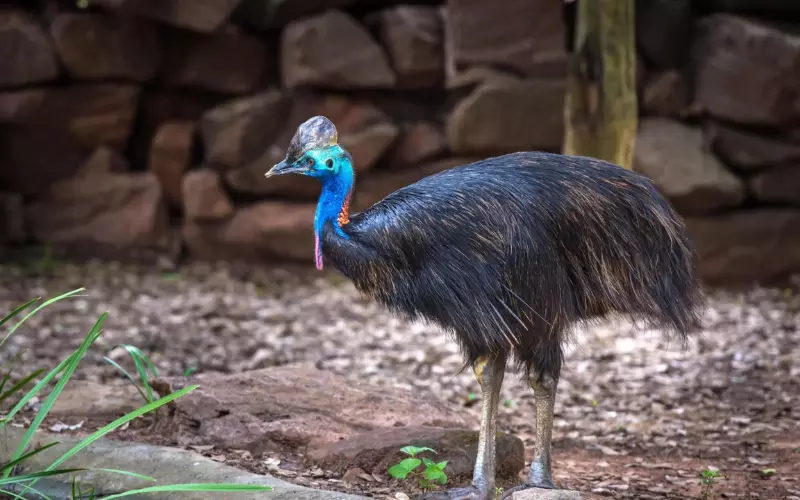
The Cassowary bird is a fascinating creature with a unique and interesting life cycle. Let’s learn about their reproduction and their growth from eggs to adults.
The Cassowary has a specific mating ritual where the male is in charge of finding a female partner. Once he finds one, he impresses her by performing a dance and making low booming sounds. If the female is interested, she will choose the male and lay her eggs in a nest on the ground. The male takes the responsibility of protecting the eggs until they hatch.
After about 50 days, the eggs crack, and little chicks come out. Unlike many other bird species, the male Cassowary takes care of the chicks. He guides them to find food and teaches them how to survive in the forest. The chicks proliferate and stay with their father for about a year.
As the chicks become more independent, they explore their surroundings and find their territories. At this stage, they are called subadults. They will eventually leave their father’s territory and find their place to live. It takes them around three years to fully mature into adult Cassowaries.
So, the life cycle of a Cassowary goes from mating rituals to the hatching of eggs, the male’s care, and the chicks’ growth into independent adults. It’s a unique process that ensures the survival of this remarkable bird species.
Threats to Cassowary
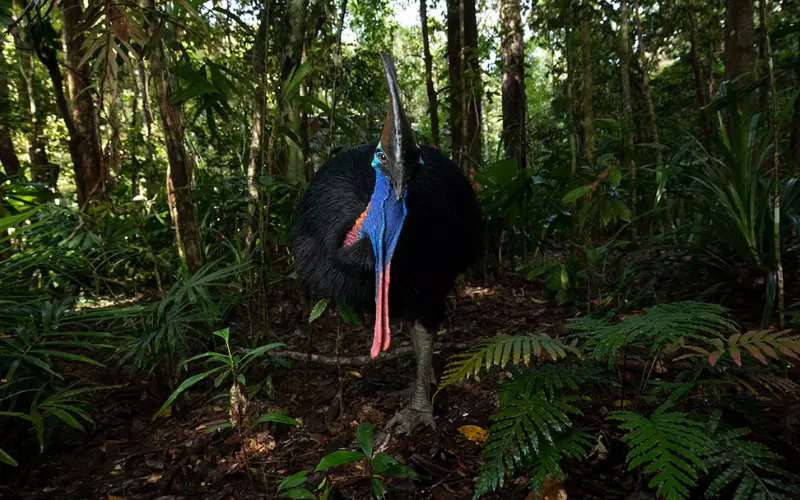
The cassowary bird faces several threats that put its survival at risk. One major threat is habitat loss due to deforestation. The cassowary’s home is destroyed when people cut down trees to create space for farming or urban development. This leaves the bird with less space to live and find food and disrupts its breeding patterns.
Another threat to the cassowary is hunting and poaching. Some people hunt cassowaries for their large feathers, which are used for decorative purposes. Others illegally capture them to sell as pets. This is harmful because it reduces the cassowary population and disrupts their natural ecosystem.
Lastly, road accidents also pose a significant threat to the cassowary bird. These birds are not afraid to wander near roads, and their dark feathers make them hard to see, especially at night. Unfortunately, many cassowaries get hit by cars while crossing roads, leading to severe injuries or even death.
To protect the cassowary bird, it is essential to conserve its habitat. Creating protected areas or national parks can help ensure the cassowary has enough space to live and breed. Additionally, enforcing laws against hunting and poaching can deter people from harming these birds. Lastly, by implementing road signs or speed limits in areas where cassowaries are known to cross, we can reduce the number of road accidents and protect these majestic birds.
The cassowary bird faces multiple threats, such as habitat loss, hunting, and road accidents. Taking steps to conserve their habitats, enforcing anti-hunting laws, and implementing road safety measures can help protect these impressive birds and ensure their survival for future generations.
Population of Cassowary

The population of the Cassowary bird is estimated to be around 20,000 to 25,000 individuals. These birds are native to the tropical rainforests of Australia, New Guinea, and nearby islands. With their distinctive tall casque on their heads and vibrant blue necks, they are considered one of the most giant flightless birds in the world.
Unfortunately, the Cassowary bird population is at risk due to factors such as habitat destruction, illegal hunting, and road accidents. The destruction of their rainforest homes for agriculture and logging reduces their available space and food sources. Illegal hunting and road accidents also pose significant threats to their survival.
If these challenges persist without proper conservation efforts, the Cassowary bird could face extinction in the future. It is crucial to protect their habitats, raise awareness about the importance of these unique birds, and enforce laws against hunting and habitat destruction. By taking these measures, we can help ensure the survival of the Cassowary bird for future generations to enjoy.
Conclusion
In the world of animals, one fascinating creature is known as the Cassowary. This remarkable bird has a history as ancient as time, dating back millions of years. The Cassowary has survived and adapted to its environment, making it a true marvel of nature.
With its majestic size and intriguing features, the Cassowary never captures our imagination. This magnificent bird can grow up to 6 feet tall and weigh around 130 pounds. Its large, powerful legs are equipped with sharp claws that aid in defence and foraging. The Cassowary’s distinctive casque, a bony crest on top of its head, adds to its unique appearance.
The Cassowary’s natural habitat can be found in the rainforests of Australia, New Guinea, and nearby islands. These birds are known for quickly navigating dense vegetation, thanks to their strong legs and incredible agility. In these lush forests, the Cassowary plays a vital role in seed dispersal, helping to maintain the balance of its ecosystem.
The Cassowary is a remarkable bird that has managed to withstand the tests of time. With its fascinating history, impressive size, and unique habitat, the Cassowary stands out in the animal kingdom. The world of animals continually surprises us with its diversity and resilience, and the Cassowary is a perfect example of nature’s incredible creations.
Frequently Asked Questions about Cassowary (FAQ’s)
What is a cassowary bird?
The cassowary bird is a large, flightless bird native to the rainforests of New Guinea and northeastern Australia.
How big do cassowary birds grow?
Cassowary birds are known to grow to an average height of 5 to 6 feet and weigh anywhere between 100 to 150 pounds.
What do cassowary birds eat?
Cassowary birds have an omnivorous diet, which includes fruits, seeds, insects, smaller animals, and even carrion.
Can cassowary birds fly?
No, cassowary birds are flightless. However, they are excellent runners and can sprint at high speeds when needed.
How dangerous are cassowary birds?
Cassowary birds have been known for being potentially dangerous due to their territorial and protective nature. They possess sharp claws on their feet and can deliver powerful kicks.
Are cassowary birds aggressive towards humans?
Cassowary birds tend to be wary and defensive around humans. However, they may become aggressive and attack if they feel threatened or cornered.
How many species of cassowary birds are there?
There are three recognized species of cassowaries: the southern cassowary, dwarf cassowary, and northern cassowary.
What are the unique features of cassowary birds?
Cassowary birds are characterized by their vibrant colours, large casque on their heads, and long, sharp claws.
Do cassowary birds make any sounds or calls?
Yes, cassowary birds use many sounds and vocalizations for communication, including booming, hissing, and rumbling calls.
How long do cassowary birds live?
In the wild, cassowary birds have an average lifespan of about 40 to 50 years. However, they can live longer in captivity, sometimes up to 70 years.
Do cassowary birds have any predators?
As adults, cassowary birds have very few natural predators. Their main threats are humans, who encroach upon their habitats, and more enormous crocodiles.
Are cassowary birds endangered?
Yes, cassowary birds are classified as endangered due to habitat loss, hunting, and other human-related factors.
Can cassowary birds swim?
Although cassowary birds are not adapted for swimming, they can cross rivers and small bodies of water by wading through them.
Do cassowary birds have any social structure?
Cassowary birds are generally solitary creatures but occasionally come together for feeding or mating.
Are cassowary birds popular as pets?
Due to their wild nature, cassowary birds are not recommended as pets. They require specialized care and sufficient space and can be dangerous to humans.

Hey there, I’m Kristen Haudenschild! I’m like a superhero for animals and people.
I work as a Dependable Hard Working Supervisor, which means I help both people and animals grow and learn. I did my school at OdySea Aquarium and Georgia Southern University in Tempe, Arizona. That’s where I learned all about animals, and guess what? I’m fascinated by them!
I even write cool articles about animals. My job history includes being an Animal Trainer and a Marine Mammal Trainer II at OdySea Aquarium. I’ve also been a Senior Animal Care Specialist and an Animal Care Specialist 2.
I love exploring animals and am always ready to help others learn more about them. So, if you ever need info about animals, give me a shout!

